


This photo taken on June 8, 2021 shows a view of Tekes County in Ili Kazak Autonomous Prefecture, northwest China's Xinjiang Uygur Autonomous Region.
Established in the 1930s, Tekes is located deep in the Ili River Valley on the northern slopes of the Tianshan Mountains. The county is renowned for its Bagua (or Eight Trigrams) layout: from the central Tai Chi Plaza, eight main streets extend outward in a progressive and radial pattern, while the roads are interconnected.
Tekes is now promoting the integrated development of its cultural and tourism industries, striving to create a "museum of landscapes" and a world-class tourist destination. (Xinhua/Ding Lei)
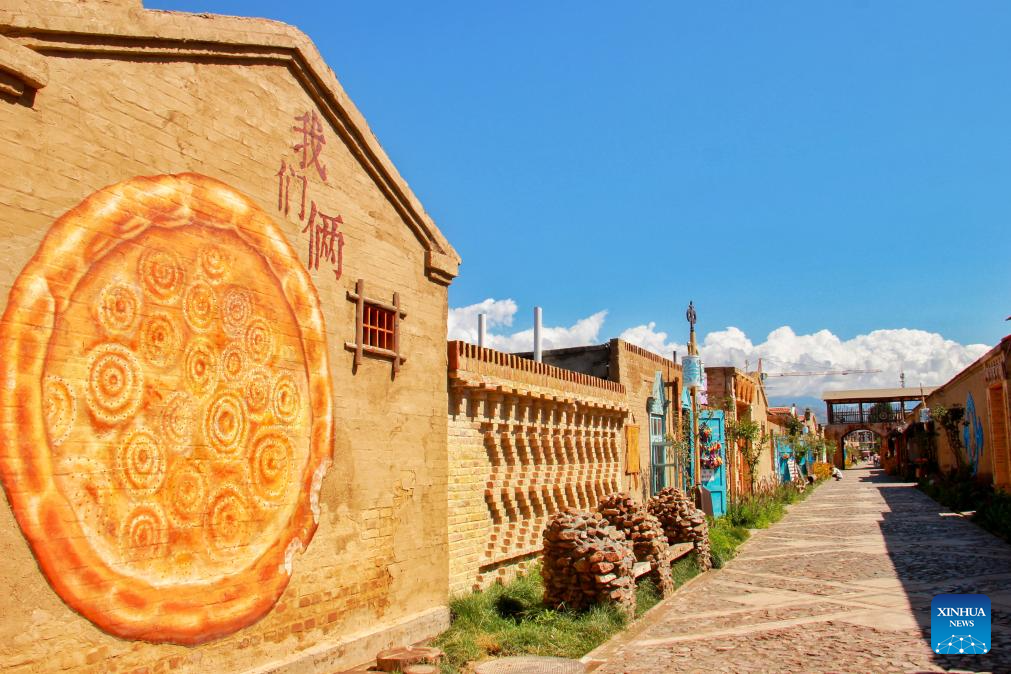
This photo taken on Aug. 18, 2019 shows a view on one of the eight main streets in Tekes County in Ili Kazak Autonomous Prefecture, northwest China's Xinjiang Uygur Autonomous Region.
Established in the 1930s, Tekes is located deep in the Ili River Valley on the northern slopes of the Tianshan Mountains. The county is renowned for its Bagua (or Eight Trigrams) layout: from the central Tai Chi Plaza, eight main streets extend outward in a progressive and radial pattern, while the roads are interconnected.
Tekes is now promoting the integrated development of its cultural and tourism industries, striving to create a "museum of landscapes" and a world-class tourist destination. (Photo by Zhao Fengshou/Xinhua)
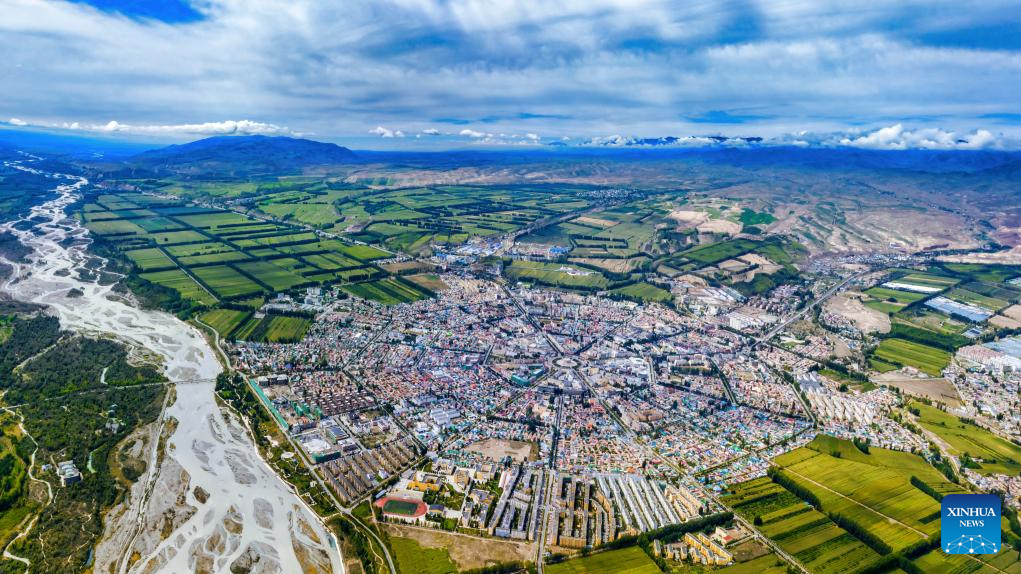
An aerial photo taken on Aug. 29, 2023 shows a view of Tekes County in Ili Kazak Autonomous Prefecture, northwest China's Xinjiang Uygur Autonomous Region.
Established in the 1930s, Tekes is located deep in the Ili River Valley on the northern slopes of the Tianshan Mountains. The county is renowned for its Bagua (or Eight Trigrams) layout: from the central Tai Chi Plaza, eight main streets extend outward in a progressive and radial pattern, while the roads are interconnected.
Tekes is now promoting the integrated development of its cultural and tourism industries, striving to create a "museum of landscapes" and a world-class tourist destination. (Photo by Zhang Qinghua/Xinhua)

An aerial photo taken on Feb. 22, 2025 shows the central Tai Chi Plaza of Tekes County in Ili Kazak Autonomous Prefecture, northwest China's Xinjiang Uygur Autonomous Region.
Established in the 1930s, Tekes is located deep in the Ili River Valley on the northern slopes of the Tianshan Mountains. The county is renowned for its Bagua (or Eight Trigrams) layout: from the central Tai Chi Plaza, eight main streets extend outward in a progressive and radial pattern, while the roads are interconnected.
Tekes is now promoting the integrated development of its cultural and tourism industries, striving to create a "museum of landscapes" and a world-class tourist destination. (Photo by Zhao Fengshou/Xinhua)

Tourists take selfies on one of the eight main streets in Tekes County in Ili Kazak Autonomous Prefecture, northwest China's Xinjiang Uygur Autonomous Region, July 23, 2021.
Established in the 1930s, Tekes is located deep in the Ili River Valley on the northern slopes of the Tianshan Mountains. The county is renowned for its Bagua (or Eight Trigrams) layout: from the central Tai Chi Plaza, eight main streets extend outward in a progressive and radial pattern, while the roads are interconnected.
Tekes is now promoting the integrated development of its cultural and tourism industries, striving to create a "museum of landscapes" and a world-class tourist destination. (Photo by Tang Yong/Xinhua)

This photo taken on Feb. 22, 2025 shows a ferris wheel in Tekes County, Ili Kazak Autonomous Prefecture, northwest China's Xinjiang Uygur Autonomous Region.
Established in the 1930s, Tekes is located deep in the Ili River Valley on the northern slopes of the Tianshan Mountains. The county is renowned for its Bagua (or Eight Trigrams) layout: from the central Tai Chi Plaza, eight main streets extend outward in a progressive and radial pattern, while the roads are interconnected.
Tekes is now promoting the integrated development of its cultural and tourism industries, striving to create a "museum of landscapes" and a world-class tourist destination. (Photo by Zhao Fengshou/Xinhua)

An aerial photo taken on May 15, 2024 shows a view of Tekes County in Ili Kazak Autonomous Prefecture, northwest China's Xinjiang Uygur Autonomous Region.
Established in the 1930s, Tekes is located deep in the Ili River Valley on the northern slopes of the Tianshan Mountains. The county is renowned for its Bagua (or Eight Trigrams) layout: from the central Tai Chi Plaza, eight main streets extend outward in a progressive and radial pattern, while the roads are interconnected.
Tekes is now promoting the integrated development of its cultural and tourism industries, striving to create a "museum of landscapes" and a world-class tourist destination. (Photo by Lai Yuning/Xinhua)
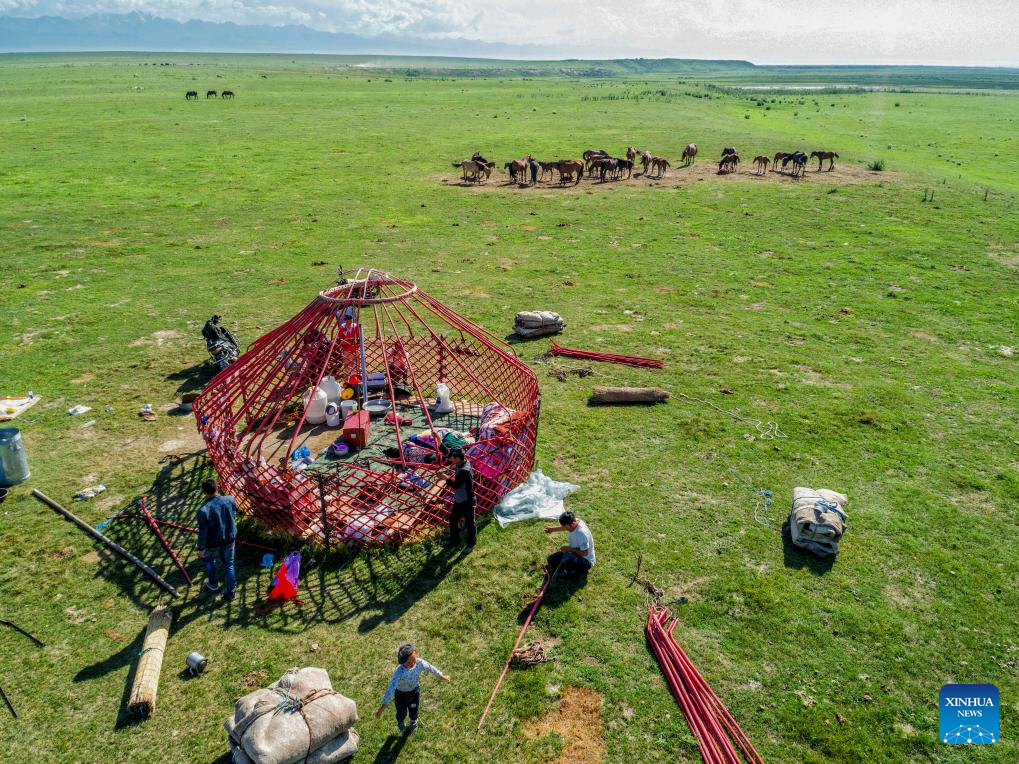
An aerial photo taken on July 7, 2017 shows herders setting up a yurt at a pasture in Tekes County, Ili Kazak Autonomous Prefecture, northwest China's Xinjiang Uygur Autonomous Region.
Established in the 1930s, Tekes is located deep in the Ili River Valley on the northern slopes of the Tianshan Mountains. The county is renowned for its Bagua (or Eight Trigrams) layout: from the central Tai Chi Plaza, eight main streets extend outward in a progressive and radial pattern, while the roads are interconnected.
Tekes is now promoting the integrated development of its cultural and tourism industries, striving to create a "museum of landscapes" and a world-class tourist destination. (Photo by Lai Yuning/Xinhua)

This photo taken on April 26, 2020 shows a view on one of the eight main streets in Tekes County in Ili Kazak Autonomous Prefecture, northwest China's Xinjiang Uygur Autonomous Region.
Established in the 1930s, Tekes is located deep in the Ili River Valley on the northern slopes of the Tianshan Mountains. The county is renowned for its Bagua (or Eight Trigrams) layout: from the central Tai Chi Plaza, eight main streets extend outward in a progressive and radial pattern, while the roads are interconnected.
Tekes is now promoting the integrated development of its cultural and tourism industries, striving to create a "museum of landscapes" and a world-class tourist destination. (Photo by Zhao Fengshou/Xinhua)

People watch a drone performance in Tekes County, Ili Kazak Autonomous Prefecture, northwest China's Xinjiang Uygur Autonomous Region, June 9, 2023.
Established in the 1930s, Tekes is located deep in the Ili River Valley on the northern slopes of the Tianshan Mountains. The county is renowned for its Bagua (or Eight Trigrams) layout: from the central Tai Chi Plaza, eight main streets extend outward in a progressive and radial pattern, while the roads are interconnected.
Tekes is now promoting the integrated development of its cultural and tourism industries, striving to create a "museum of landscapes" and a world-class tourist destination. (Photo by Zhao Fengshou/Xinhua)

An aerial photo taken on Dec. 30, 2023 shows a view of Tekes County in Ili Kazak Autonomous Prefecture, northwest China's Xinjiang Uygur Autonomous Region.
Established in the 1930s, Tekes is located deep in the Ili River Valley on the northern slopes of the Tianshan Mountains. The county is renowned for its Bagua (or Eight Trigrams) layout: from the central Tai Chi Plaza, eight main streets extend outward in a progressive and radial pattern, while the roads are interconnected.
Tekes is now promoting the integrated development of its cultural and tourism industries, striving to create a "museum of landscapes" and a world-class tourist destination. (Photo by Zhou Meiling/Xinhua)
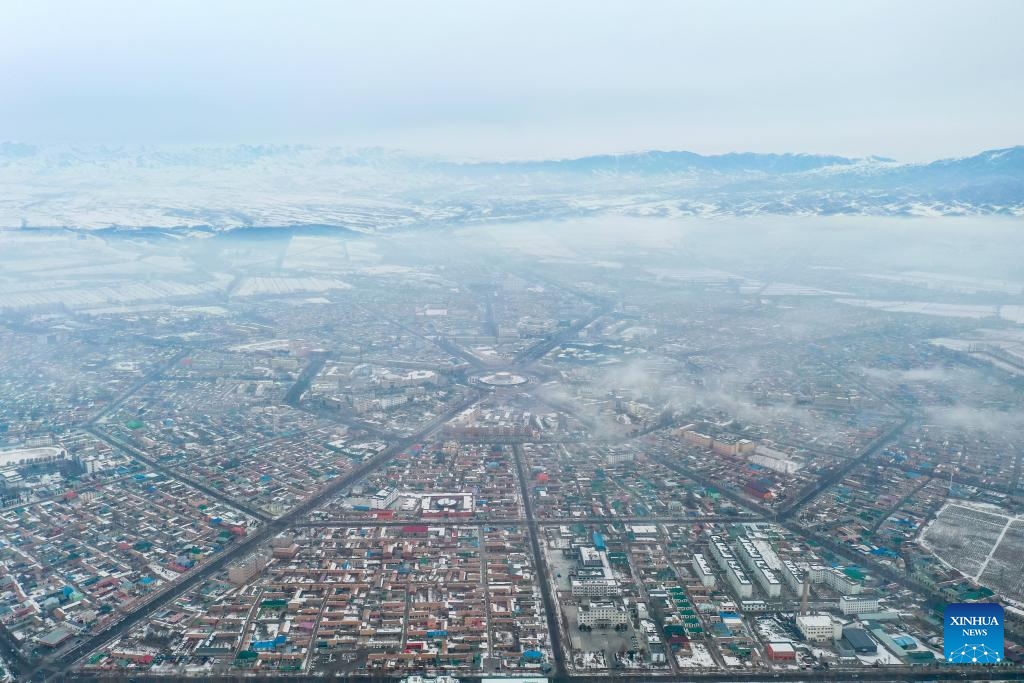
An aerial photo taken on Jan. 2, 2021 shows a view of Tekes County in Ili Kazak Autonomous Prefecture, northwest China's Xinjiang Uygur Autonomous Region.
Established in the 1930s, Tekes is located deep in the Ili River Valley on the northern slopes of the Tianshan Mountains. The county is renowned for its Bagua (or Eight Trigrams) layout: from the central Tai Chi Plaza, eight main streets extend outward in a progressive and radial pattern, while the roads are interconnected.
Tekes is now promoting the integrated development of its cultural and tourism industries, striving to create a "museum of landscapes" and a world-class tourist destination. (Xinhua/Ding Lei)

People watch artistic performances at the opening of a martial arts competition in Tekes County, Ili Kazak Autonomous Prefecture, northwest China's Xinjiang Uygur Autonomous Region, July 25, 2024.
Established in the 1930s, Tekes is located deep in the Ili River Valley on the northern slopes of the Tianshan Mountains. The county is renowned for its Bagua (or Eight Trigrams) layout: from the central Tai Chi Plaza, eight main streets extend outward in a progressive and radial pattern, while the roads are interconnected.
Tekes is now promoting the integrated development of its cultural and tourism industries, striving to create a "museum of landscapes" and a world-class tourist destination. (Photo by Zhao Fengshou/Xinhua)
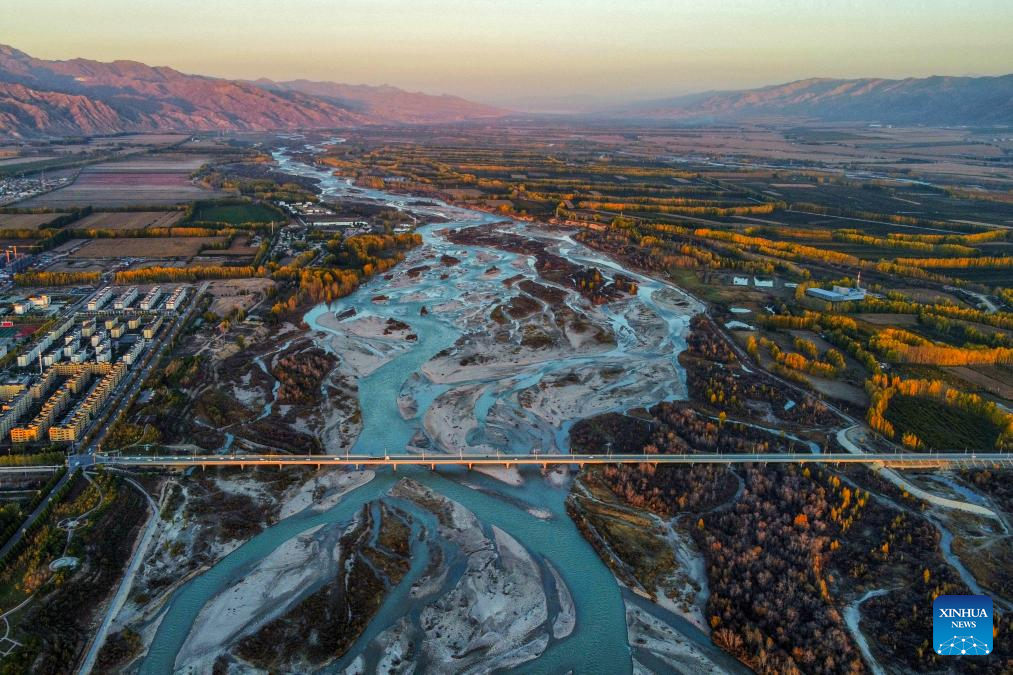
An aerial photo taken on Oct. 9, 2024 shows a view of the Tekes River in Tekes County, Ili Kazak Autonomous Prefecture, northwest China's Xinjiang Uygur Autonomous Region.
Established in the 1930s, Tekes is located deep in the Ili River Valley on the northern slopes of the Tianshan Mountains. The county is renowned for its Bagua (or Eight Trigrams) layout: from the central Tai Chi Plaza, eight main streets extend outward in a progressive and radial pattern, while the roads are interconnected.
Tekes is now promoting the integrated development of its cultural and tourism industries, striving to create a "museum of landscapes" and a world-class tourist destination. (Photo by Zhao Fengshou/Xinhua)

An aerial photo taken on Jan. 2, 2021 shows a night view of Tekes County in Ili Kazak Autonomous Prefecture, northwest China's Xinjiang Uygur Autonomous Region.
Established in the 1930s, Tekes is located deep in the Ili River Valley on the northern slopes of the Tianshan Mountains. The county is renowned for its Bagua (or Eight Trigrams) layout: from the central Tai Chi Plaza, eight main streets extend outward in a progressive and radial pattern, while the roads are interconnected.
Tekes is now promoting the integrated development of its cultural and tourism industries, striving to create a "museum of landscapes" and a world-class tourist destination. (Xinhua/Ding Lei)

A panoramic aerial photo taken on Jan. 2, 2021 shows a view of Tekes County in Ili Kazak Autonomous Prefecture, northwest China's Xinjiang Uygur Autonomous Region.
Established in the 1930s, Tekes is located deep in the Ili River Valley on the northern slopes of the Tianshan Mountains. The county is renowned for its Bagua (or Eight Trigrams) layout: from the central Tai Chi Plaza, eight main streets extend outward in a progressive and radial pattern, while the roads are interconnected.
Tekes is now promoting the integrated development of its cultural and tourism industries, striving to create a "museum of landscapes" and a world-class tourist destination. (Xinhua/Ding Lei)

An aerial photo taken on Jan. 9, 2025 shows a view of Tekes County in Ili Kazak Autonomous Prefecture, northwest China's Xinjiang Uygur Autonomous Region.
Established in the 1930s, Tekes is located deep in the Ili River Valley on the northern slopes of the Tianshan Mountains. The county is renowned for its Bagua (or Eight Trigrams) layout: from the central Tai Chi Plaza, eight main streets extend outward in a progressive and radial pattern, while the roads are interconnected.
Tekes is now promoting the integrated development of its cultural and tourism industries, striving to create a "museum of landscapes" and a world-class tourist destination. (Photo by Zhao Fengshou/Xinhua)

Tourists enjoy artistic performances in Tekes County, Ili Kazak Autonomous Prefecture, northwest China's Xinjiang Uygur Autonomous Region, July 23, 2021.
Established in the 1930s, Tekes is located deep in the Ili River Valley on the northern slopes of the Tianshan Mountains. The county is renowned for its Bagua (or Eight Trigrams) layout: from the central Tai Chi Plaza, eight main streets extend outward in a progressive and radial pattern, while the roads are interconnected.
Tekes is now promoting the integrated development of its cultural and tourism industries, striving to create a "museum of landscapes" and a world-class tourist destination. (Photo by Tang Yong/Xinhua)
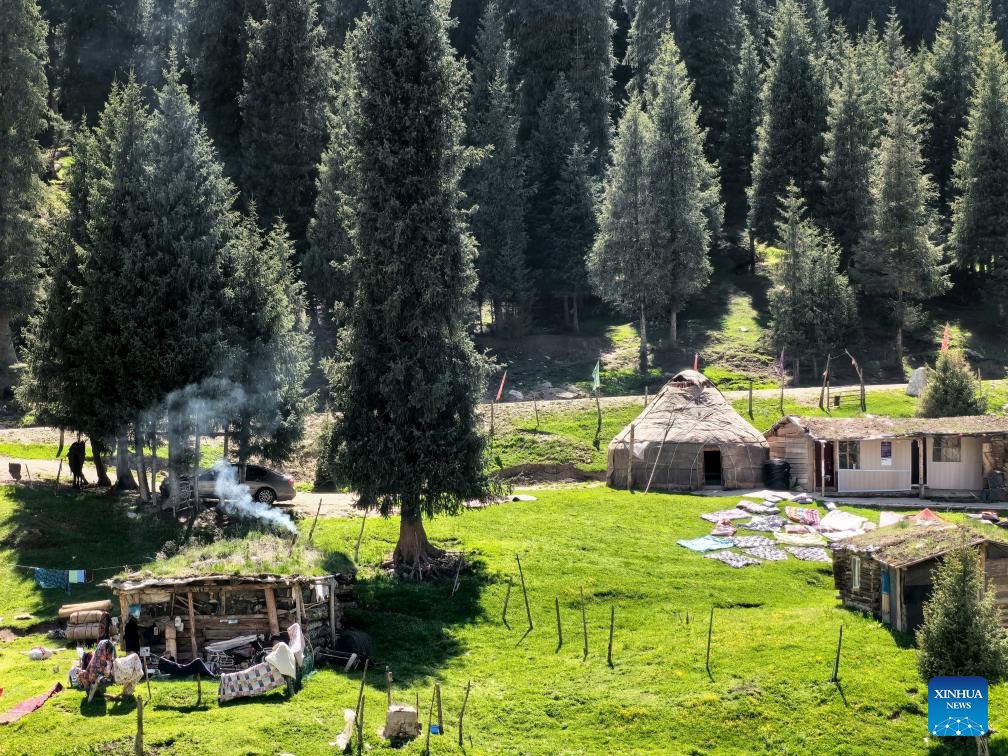
An aerial photo taken on May 15, 2024 shows a pasture in Tekes County, Ili Kazak Autonomous Prefecture, northwest China's Xinjiang Uygur Autonomous Region.
Established in the 1930s, Tekes is located deep in the Ili River Valley on the northern slopes of the Tianshan Mountains. The county is renowned for its Bagua (or Eight Trigrams) layout: from the central Tai Chi Plaza, eight main streets extend outward in a progressive and radial pattern, while the roads are interconnected.
Tekes is now promoting the integrated development of its cultural and tourism industries, striving to create a "museum of landscapes" and a world-class tourist destination. (Photo by Zhang Qinghua/Xinhua)

This photo taken on May 14, 2024 shows a view of Tekes County in Ili Kazak Autonomous Prefecture, northwest China's Xinjiang Uygur Autonomous Region.
Established in the 1930s, Tekes is located deep in the Ili River Valley on the northern slopes of the Tianshan Mountains. The county is renowned for its Bagua (or Eight Trigrams) layout: from the central Tai Chi Plaza, eight main streets extend outward in a progressive and radial pattern, while the roads are interconnected.
Tekes is now promoting the integrated development of its cultural and tourism industries, striving to create a "museum of landscapes" and a world-class tourist destination. (Photo by Lai Yuning/Xinhua)

This photo taken on July 27, 2018 shows a view on one of the eight main streets in Tekes County in Ili Kazak Autonomous Prefecture, northwest China's Xinjiang Uygur Autonomous Region.
Established in the 1930s, Tekes is located deep in the Ili River Valley on the northern slopes of the Tianshan Mountains. The county is renowned for its Bagua (or Eight Trigrams) layout: from the central Tai Chi Plaza, eight main streets extend outward in a progressive and radial pattern, while the roads are interconnected.
Tekes is now promoting the integrated development of its cultural and tourism industries, striving to create a "museum of landscapes" and a world-class tourist destination. (Photo by Zhao Fengshou/Xinhua)
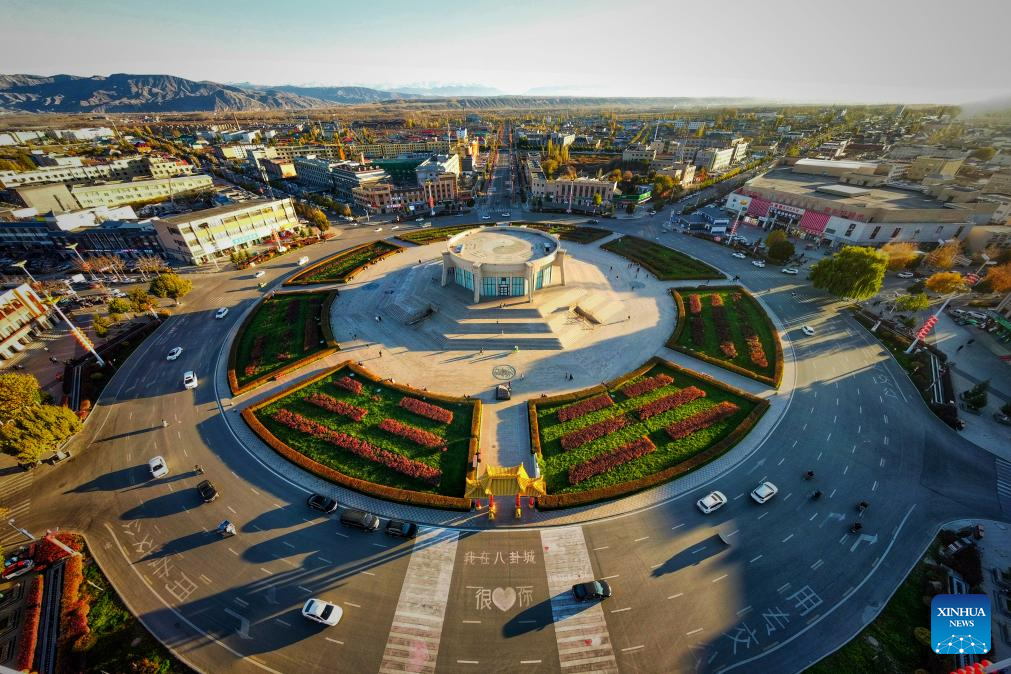
An aerial photo taken on Nov. 4, 2023 shows the central Tai Chi Plaza of Tekes County in Ili Kazak Autonomous Prefecture, northwest China's Xinjiang Uygur Autonomous Region.
Established in the 1930s, Tekes is located deep in the Ili River Valley on the northern slopes of the Tianshan Mountains. The county is renowned for its Bagua (or Eight Trigrams) layout: from the central Tai Chi Plaza, eight main streets extend outward in a progressive and radial pattern, while the roads are interconnected.
Tekes is now promoting the integrated development of its cultural and tourism industries, striving to create a "museum of landscapes" and a world-class tourist destination. (Photo by Zhao Fengshou/Xinhua)
点击右上角![]() 微信好友
微信好友
 朋友圈
朋友圈

请使用浏览器分享功能进行分享
